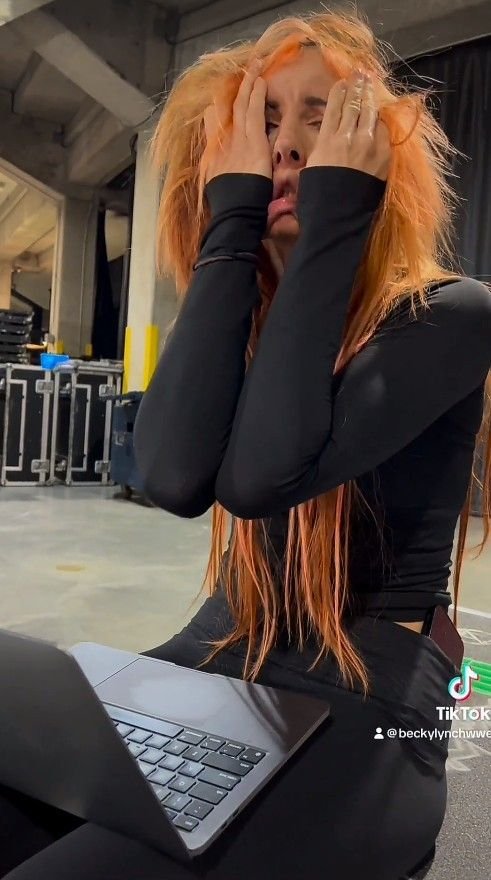
The Disdainful Gaze: Decoding Moxley’s Scowl and the Unlikely Prospect of Harley Hudson
The arena is a cacophony of controlled chaos. The roar of the crowd is a physical force, the air thick with sweat and anticipation. In the midst of it all stands Jon Moxley, a man who wears violence like a well-tailored suit. His eyes, often glazed with a kind of manic serenity, are instead sharp, focused, and critically scanning the ring. He’s not watching a main event titan; he’s watching a preliminary match. His subject: a young, fiery, and immensely green prospect known as Harley Hudson. Hudson is giving it his all—the high-flying crossbody, the stiff strikes, the passionate selling—but as the camera cuts to Moxley, leaning against the barricade with his arms crossed, the message is clear. He is… not impressed.
This isn’t a new posture for Moxley. The former AEW World Champion has long positioned himself as the gatekeeper, the bastion of legitimacy in an industry increasingly filled with “cosplay wrestlers,” as he might put it. But this specific instance of disdain raises a compelling question: Is the Purveyor of Violence still scouting? And if so, what does his palpable lack of interest in Hudson’s flashy style reveal about his philosophy and the future he envisions for this business?
To understand Moxley’s scowl is to understand his entire creed. Moxley’s world is not one of aerial artistry or choreographed sequences designed for a viral highlight reel. His is a world of grit, grime, and authenticity. It’s a world where a match isn’t won with the most impressive move, but with the most effective one. It’s a world built on the foundations of pain, endurance, and an almost nihilistic will to survive. When he looks at a performer like Harley Hudson, he doesn’t see a future star; he likely sees a collection of moves in search of a soul. He sees a performer who has studied the “what” of wrestling but has yet to grasp the “why.”
The “why” for Moxley is survival. Every match he’s in, from a bloody Deathmatch to a standard TV bout, is framed as a fight for his very existence. His selling isn’t just about making an opponent’s move look good; it’s a visceral reaction to perceived trauma. His offense isn’t a series of spots; it’s the desperate, violent outburst of a man backed into a corner. This is the intangible quality—the psychology, the story, the heart—that he finds lacking in many of today’s new talents. Hudson might execute a perfect 450 splash, but does Moxley believe he could survive a 30-minute war in the G1 Climax? Could he navigate the brutal landscape of a Blood & Guts match? In Moxley’s eyes, probably not. The flashy offense is meaningless without the foundational toughness to back it up.
This brings us back to the idea of Moxley the Scout. He may no longer hold the official title of champion, but he operates with the authority of a permanent, unofficial one. His role has evolved from top guy to curator. He is constantly assessing the landscape, identifying who belongs in his world of violent realism and who is merely passing through. His endorsement, often given not with words but with a nod of respect after a hard-fought battle, is one of the most valuable commodities in the locker room. To earn Moxley’s approval is to earn a certificate of authenticity.
His scouting method is unorthodox. It’s not about win-loss records or social media metrics. It’s conducted in the trenches: during a wild brawl on the ramp, in the thick of a multi-man tag match where instincts take over, or in the grueling stretches of a time-limit draw. He’s looking for the tell-tale signs of a real fighter. Does the wrestler have a second gear when they’re exhausted? Do they make the struggle look real? Do they understand that sometimes a well-timed forearm or a stiff lariat can be more devastating and get more crowd reaction than a complex, setup-dependent finisher?
Harley Hudson, in this hypothetical scenario, represents a archetype that Moxley has historically clashed with. Hudson is all potential and athleticism, a blank canvas upon which a persona has yet to be truly carved in blood and struggle. His moves are impressive, but they might feel disconnected from a larger narrative. Moxley’s lack of impression, therefore, is not a final judgment on Hudson’s career, but rather a critique of his current presentation. It’s a challenge, whether he intends it to be or not.
In the economy of professional wrestling, disdain from a figure like Moxley can be more valuable than praise from others. It creates a narrative hook. The story writes itself: The young, flashy rookie, hungry for validation, constantly running into the wall of the grizzled veteran’s indifference. Every time Moxley is on commentary during a Hudson match, the audience will wait for that begrudging compliment that never comes. Every backstage encounter will be charged with unspoken tension. This dynamic is pure gasoline for a future feud.
Perhaps one day, Hudson will be thrown into an impossible situation—a last-minute replacement against Moxley himself, or a brutal stipulation match that forces him to dig deeper than he ever has. And in that moment, when he’s bleeding, exhausted, and pushed to his absolute limit, he might tap into something real. He might stop performing and start fighting. And from the corner of the eye, we might see Moxley, his arms no longer crossed, but with a single, slight, almost imperceptible nod.
That nod wouldn’t mean Harley Hudson had won a match. It would mean he had passed a test. It would mean he had finally given the scout something to be impressed by. Until then, Moxley’s disinterested gaze will remain the highest barrier to entry—a silent, stern reminder that in his ring, athleticism is optional, but authenticity is mandatory. The scout isn’t looking for the next big thing; he’s looking for the real thing. And he’s perfectly willing to wait.



